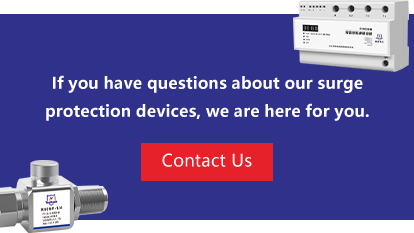Combination type surge protection devices (SPDs) are advanced surge protection systems designed to provide enhanced protection against transient overvoltages and surges in electrical systems. They typically combine multiple surge protection technologies to offer a comprehensive and robust defense. Here are some features and applications of Combination type surge protection devices:
1. Multistage Protection:
Combination type SPDs incorporate multiple stages of protection, often combining technologies such as gas discharge tubes (GDTs), metal oxide varistors (MOVs), and other protective elements in a single device.
Each stage is optimized for specific voltage levels and response times, providing a layered defense against different types and magnitudes of surges.
2. Low Let-Through Voltage:
These devices aim to limit the let-through voltage to a minimum level, reducing the risk of damage to sensitive electronic equipment connected to the power system.
3. High Surge Current Capacity:
Combination type SPDs are designed to handle high surge currents, which is crucial for protecting against severe transients commonly associated with lightning strikes or large electrical disturbances.
4. Thermal Protection:
Many Combination type SPDs incorporate thermal protection mechanisms to dissipate excess energy and prevent the device from overheating during prolonged surge events.
5. Remote Monitoring and Indication:
Some advanced models feature remote monitoring capabilities, allowing users to monitor the status of the SPD remotely. Indicators such as LED lights provide real-time information about the device's operational status.
6. Modular Design:
Modular Combination type SPDs often consist of replaceable modules, making it easier to replace damaged or worn-out components without replacing the entire surge protection unit.
Power Distribution Systems:
Combination type SPDs are commonly installed at various points in power distribution systems, including main distribution panels, subpanels, and individual equipment to protect against surges and voltage spikes.
Data Centers:
Data centers rely heavily on electronic equipment that is sensitive to voltage fluctuations. Combination type SPDs are used to protect servers, networking equipment, and other critical infrastructure.
Industrial Facilities:
Industries with complex electrical systems, such as manufacturing plants, use Combination type SPDs to safeguard PLCs (Programmable Logic Controllers), motors, control systems, and other electronic components.
Telecommunication Networks:
Telecommunication infrastructure, including base stations and communication equipment, is vulnerable to surges. Combination type SPDs help ensure the reliable operation of these systems.
Commercial and Residential Buildings:
Combination type SPDs can be installed in commercial and residential buildings to protect electrical panels, appliances, and other electronic devices from transient overvoltages.
Renewable Energy Installations:
Solar inverters, wind turbines, and other components of renewable energy systems can be protected by Combination type SPDs to ensure their longevity and performance.
Combination type surge protection devices play a crucial role in maintaining the reliability and longevity of electrical and electronic systems by mitigating the damaging effects of transient overvoltages.
 Do surge protectors work against lightning?April 27, 2025Although surge protectors cannot directly prevent lightning strikes, they can significantly reduce the damage caused by lightning strikes to electrical equipment and circuits. As a specially designed ...view
Do surge protectors work against lightning?April 27, 2025Although surge protectors cannot directly prevent lightning strikes, they can significantly reduce the damage caused by lightning strikes to electrical equipment and circuits. As a specially designed ...view What is the Residual Voltage of the Surge Protector?March 23, 2022What is the residual voltage of the surge protector? When the SPD device is selected and adapted, its various parameters will be comprehensively considered, and a comprehensive selection will be made....view
What is the Residual Voltage of the Surge Protector?March 23, 2022What is the residual voltage of the surge protector? When the SPD device is selected and adapted, its various parameters will be comprehensively considered, and a comprehensive selection will be made....view Introduction to Signal Surge Protector and Its Lightning Protection FunctionMarch 4, 2022A signal surge protector is a type of surge protection devices that is linked in series on a signal line to reduce transient over-voltages and deflect surge currents away from the signal line. Signal ...view
Introduction to Signal Surge Protector and Its Lightning Protection FunctionMarch 4, 2022A signal surge protector is a type of surge protection devices that is linked in series on a signal line to reduce transient over-voltages and deflect surge currents away from the signal line. Signal ...view Technical characteristics of SPDSeptember 8, 2021The important technical characteristics of SPDMaximum continuous operating voltage UCThe maximum continuous operating voltage (old: rated voltage) is the maximum root mean square value (rms) of the al...view
Technical characteristics of SPDSeptember 8, 2021The important technical characteristics of SPDMaximum continuous operating voltage UCThe maximum continuous operating voltage (old: rated voltage) is the maximum root mean square value (rms) of the al...view Choosing The Right Lightning Protection Device For Building ResilienceJanuary 10, 2024Ensuring the safety and resilience of buildings against lightning strikes is a paramount consideration in structural design and risk management. The choice of a lightning protection device for buildin...view
Choosing The Right Lightning Protection Device For Building ResilienceJanuary 10, 2024Ensuring the safety and resilience of buildings against lightning strikes is a paramount consideration in structural design and risk management. The choice of a lightning protection device for buildin...view Surge Protector Safety TipsFebruary 29, 2024When it comes to protecting your electronics from harmful power surges, surge protectors are an essential tool. These devices help regulate the flow of electricity to your devices, preventing damage f...view
Surge Protector Safety TipsFebruary 29, 2024When it comes to protecting your electronics from harmful power surges, surge protectors are an essential tool. These devices help regulate the flow of electricity to your devices, preventing damage f...view